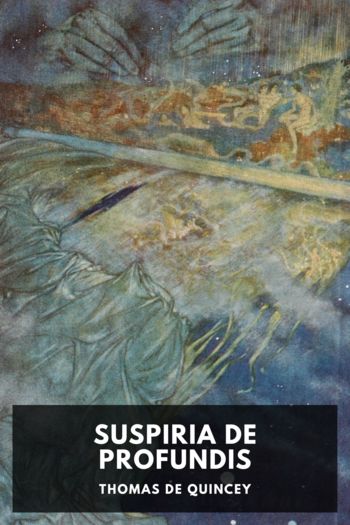Suspiria de Profundis by Thomas De Quincey (urban books to read .TXT) 📕

- Author: Thomas De Quincey
Book online «Suspiria de Profundis by Thomas De Quincey (urban books to read .TXT) 📕». Author Thomas De Quincey
By Thomas De Quincey.
Table of Contents Titlepage Imprint Editor’s Preface Suspiria de Profundis Dreaming The Affliction of Childhood The English Mail-Coach I: The Glory of Motion Going Down with Victory II: The Vision of Sudden Death III: Dream-Fugue: Founded on the Preceding Theme of Sudden Death I II III IV V The Palimpsest of the Human Brain Vision of Life Memorial Suspiria Levana and Our Ladies of Sorrow The Solitude of Childhood The Dark Interpreter The Apparition of the Brocken Savannah-La-Mar The Daughter of Lebanon The Princess Who Overlooked One Seed in a Pomegranate Who Is This Woman That Beckoneth and Warneth Me from the Place Where She Is, and in Whose Eyes Is Woeful Remembrance? I Guess Who She Is Endnotes Colophon Uncopyright ImprintThis ebook is the product of many hours of hard work by volunteers for Standard Ebooks, and builds on the hard work of other literature lovers made possible by the public domain.
This particular ebook is based on a transcriptions produced for Standard Ebooks and Project Gutenberg, and on digital scans available at the Internet Archive, the HathiTrust Digital Library, and Google Books.
The writing and artwork within are believed to be in the U.S. public domain, and Standard Ebooks releases this ebook edition under the terms in the CC0 1.0 Universal Public Domain Dedication. For full license information, see the Uncopyright at the end of this ebook.
Standard Ebooks is a volunteer-driven project that produces ebook editions of public domain literature using modern typography, technology, and editorial standards, and distributes them free of cost. You can download this and other ebooks carefully produced for true book lovers at standardebooks.org.
Editor’s PrefaceThe Suspiria have a complex publication history. De Quincey originally published them in Blackwood’s Magazine in 1845, intending them to be a kind of sequel to his Confessions of an English Opium-Eater. In their first incarnation, “Dreaming” was presented as an “Introductory Notice,” and “Vision of Life” and “Memorial Suspiria” were joined as a single “Part 2.”
De Quincey later edited and released an updated version of the Suspiria in his Collected Works, with the exception of “The Affliction of Childhood,” which he merged into his larger Autobiographic Sketches. The Collected Works versions are the versions presented here, along with the initial, independent version of “The Affliction of Childhood.” Several Suspiria appeared as posthumous publications, and they’re included here as well.
De Quincey ultimately planned for the Suspiria to be published together in a single volume. Unfortunately he didn’t live to see his plan completed, and today only those Suspiria remain that escaped time, fire, and addiction. They’re presented in this edition not in the order in which they were originally published, but in the order suggested by Alexander H. Japp in his The Posthumous Works of Thomas De Quincey, Volume I.
Of the Suspiria published during De Quincey’s life, to date only the Blackwood’s editions have been available as digital transcriptions. The edition you’re reading now is, to the editor’s knowledge, the first digital transcription of the later Collected Works versions.
“Dreaming,” “The Palimpsest of the Human Brain,” “Vision of Life,” “Memorial Suspiria,” “Levana and Our Ladies of Sorrow,” and “Savannah-La-Mer” were transcribed from De Quincey’s Collected Writings Volume XIII, edited by David Masson. A paragraph at the end of “The Affliction of Childhood,” which is duplicated in “Dreaming,” has been removed.
“Daughter of Lebanon” was transcribed from Volume III of the same set.
“The Apparition of the Brocken” was transcribed from Confessions of an English Opium-Eater, and Kindred Papers.
Alex Cabal
Chicago, December 2016
Suspiria de Profundis DreamingIn 1821, as a contribution to a periodical work—in 1822, as a separate volume—appeared the Confessions of an English Opium-Eater. The object of that work was to reveal something of the grandeur which belongs potentially to human dreams. Whatever may be the number of those in whom this faculty of dreaming splendidly can be supposed to lurk, there are not, perhaps, very many in whom it is developed. He whose talk is of oxen will probably dream of oxen; and the condition of human life, which yokes so vast a majority to a daily experience incompatible with much elevation of thought, oftentimes neutralises the tone of grandeur in the reproductive faculty of dreaming, even for those whose minds are populous with solemn imagery. Habitually to dream magnificently, a man must have a constitutional determination to reverie. This in the first place; and even this, where it exists strongly, is too much liable to disturbance from the gathering agitation of our present English life. Already, what by the procession through fifty years of mighty revolutions amongst the kingdoms of the Earth, what by the continual development of vast physical agencies—steam in all its applications, light getting under harness as a slave for man, powers from heaven descending upon education and accelerations of the press, powers from hell (as it might seem, but these also celestial) coming round upon artillery and the forces of destruction—the eye of the calmest observer is troubled; the brain is haunted as if by some jealousy of ghostly beings moving amongst us; and it becomes too evident that, unless this colossal pace of advance can be retarded (a thing not to be expected), or, which is happily more probable, can be met by counter-forces of corresponding magnitude—forces in the direction of religion or profound philosophy that shall radiate centrifugally against this storm of life so perilously centripetal towards the vortex of the merely human—left to itself, the natural tendency of so chaotic a tumult must be to evil; for some minds to lunacy, for others a reagency of





Comments (0)